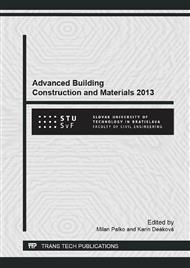[1]
STN EN 15026: 2007 – Hygrothermal performance of building components and building elements - Assessment of moisture transfer by numerical simulation.
DOI: 10.3403/30124008u
Google Scholar
[2]
SANDERS, C.: IEA ANNEX 24, Final report, Vol. 2, Task 2: Environmental conditions. Leuven, 1996. ISBN 90-75741-03-0.
Google Scholar
[3]
BLOCKEN, B. – CARMELIET, J.: A review of wind-driven rain research in building science. In Journal of Wind Engineering and Industrial Aerodynamics [online] 13/2004. p.1079–1130. [cit. 2010-01-10].
DOI: 10.1016/j.jweia.2004.06.003
Google Scholar
[4]
KUBILAY, A. et al.: CFD simulation and validation of wind-driven rain on a building facade with an Eulerian multiphase model. In Building and Enviroment. [online] 61/2013. p.69–81. [cit. 2013-04-20].
DOI: 10.1016/j.buildenv.2012.12.005
Google Scholar
[5]
JURÁŠ. P. – ŽILINSKÝ, J.: Measuremtns of wind-driven rain absorptivity of various coatings in rain chamber. In ATF 2013: 2nd Conference on Acoustics, Light and Thermal Physics in Architecture and Building Structures. Book of proceedings. Leuven, Belgium 2. -3. 5. 2013. Leuven: Katholieke Universiteit Leuven, 2013, pp.78-84.
DOI: 10.3842/sigma.2023.020
Google Scholar
[6]
KORONTHÁLYOVÁ, O. – MATIAŠOVSKÝ, P.: Driving rain course simulation based on daily data. In Journal of Thermal Enviroment & Building science, vol. 25 – July (2001).
DOI: 10.1106/n8xw-r4cu-62tm-4j2h
Google Scholar
[7]
JURÁŠ, P. – KAJABA, P. – ŽILINSKÝ, J.: Potreba a využitie klimatických referenčných rokov stavebníctve. [Need for and usage of test reference years in civil engineering] In Meteorologický časopis / Meteorological Journal. č. 2/2011, roč. 14. pp.63-67.
Google Scholar


